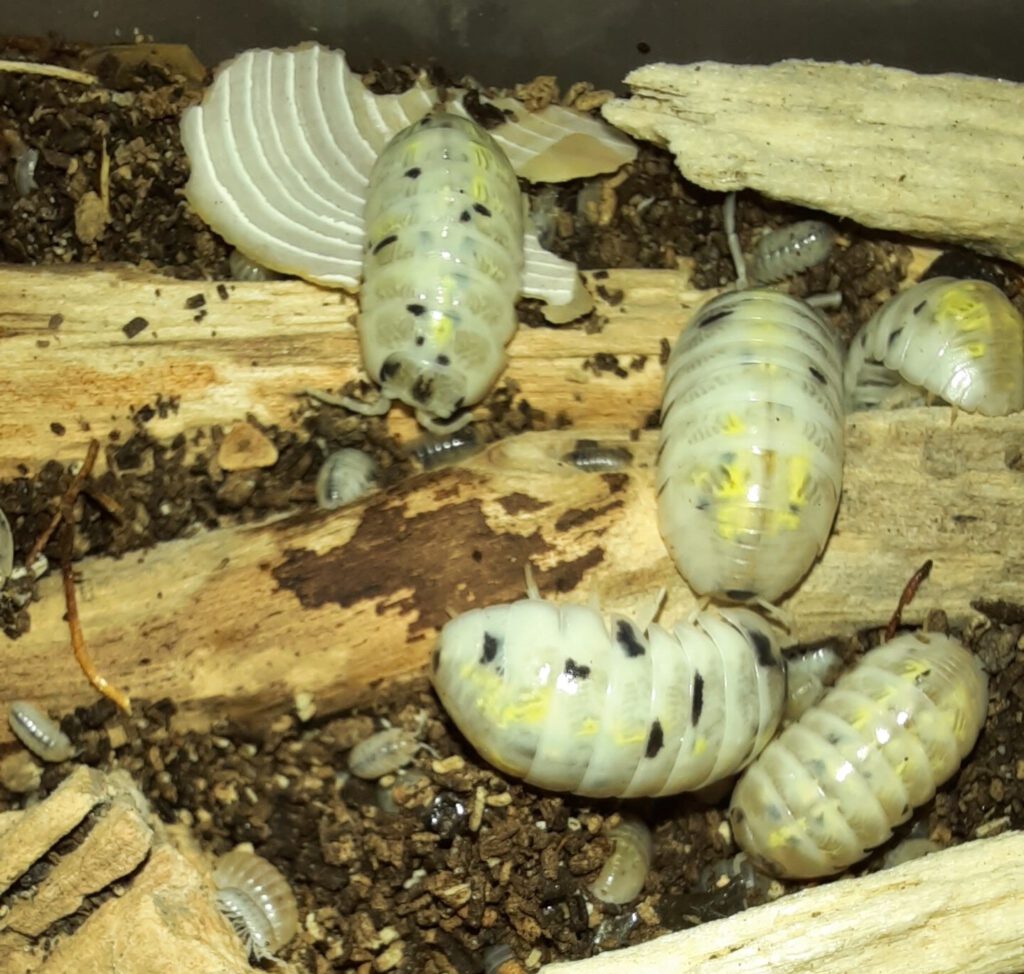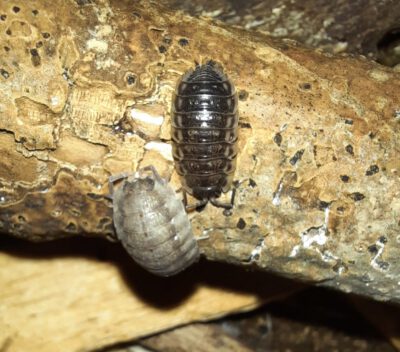picture by Liliana Sanfilippo
This article is not yet finished!
If you want to write/help with this or another (or new!) article, please contact me 🙂
(as of 17.03.2024)

| English | German | Name |
| Order | Ordnung | Isopoda |
| Suborder | Unterordnung | Oniscidea |
| Family | Familie | Oniscidae |
| Genus | Gattung | Oniscus |
| Species | Art | Oniscus asellus |
Description
They are mostly gray, rather flat and can grow up to 18 mm long and 10 mm broad. Their shape is significantly more oval compare to other rather flat species such as Porcellio.
Their cuticle is shiny and has low tubercules on the pereonites (on the back) and on the vertex (on top of the head). The pleonites (the part before the telson) is smooth. Generally, adults are smoother than juveniles. There are no gaps between the pereonites. The tips of the epimerae are pointed and the front ones posterior sites are curved, especially the posterior site of the first epimera.
Their main colour goes from light gray to brown to almost black. Some have pale edges or grey or yellow dots on their back. Through breeding, today exist other colour morphs that greatly differ from their natural colours.
Their lateral lobes are long and the frontal area is a little bit projecting but not really hanging over. The antenna has a flagellum with three links and sensory hair at the tip.
The eyes are compound eyes with about 20 ocelli each.
They usually live one or two years but some specimen have been observed to live over 4 years.
Habitat
It is mostly found in woods or other places that offer a lot of decaying wood and can survive in areas with little calcium. They can even live in moors and bogs. They are said to be able to tolerate acidic soil.
They can often be found under the bark of rotting trees.
Distribution
They are very common in Europe except in the Mediterranean area and can also be found in North America.
Care
They need more moisture than Porcellios and are more sensitive to drought. They prefer dark spaces and therefor need a lot of hiding.
First Description
Linnaeus, C. (1758). Systema Naturae per regna tria naturae, secundum classes, ordines, genera, species, cum characteribus, differentiis, synonyms, locis. Editio decima, reformata [10th revised edition], vol. 1: 824 pp. Laurentius Salvius: Holmiae.
You can find a download here.
Names
English: woodlouse, common (shiny) woodlouse, sow bug
Deutsch: Mauerassel
Fracais: L’ Aselle des murs
Synonyms
- Oniscus affinis Say, 1818
- Oniscus fossor C. Koch, 1838
- Oniscus lamperti L. Koch, 1901
- Oniscus languidus L. Koch, 1901
- Oniscus murarius Cuvier, 1792
- Oniscus nodulosus Verhoeff, 1934
- Oniscus vicarius Stuxberg, 1872
- Porcellio lineatus Fitch, 1855
- Porcellio taeniola C. Koch, 1835
Subspecies
O. asellus asellus
O. asellus occidentalis
Developement
The young ones look quite different from the adult ones since they appear longer and do not have the shiny surface yet.
Behaviour
When disturbed, they flee since they can not roll up and do not have other defense mechanisms. They tend to press onto their hiding space very firmly to a degree that it can be difficult to pick them up. Generally, they avoid light.
Trivia
In Germany, this isopod was voted “Höhlentier des Jahres” (Cave animal of the year) in 2020.
Apparently, some people believe they are a remedy for some health problems, including “Boring pain behind right ear in mastoid process”.
- https://en.wikipedia.org/wiki/Oniscus_asellus
- https://de.wikipedia.org/wiki/Mauerassel
- https://www.marinespecies.org/aphia.php?p=taxdetails&id=257580
- https://fr.wikipedia.org/wiki/Aselle_des_murs
- https://www.bmig.org.uk/species/oniscus-asellus-ssp-asellus
- https://web.archive.org/web/20100429175351/http://www.arkive.org/common-woodlouse/oniscus-asellus/info.html
- https://www.webhomeopath.com/homeopathy/homeopathic-remedies/homeopathy-remedy-Oniscus_Asellus.html
- Bilton, D., Goode, D. & Mallet, J. Genetic differentiation and natural hybridization between two morphological forms of the common woodlouse, Oniscus asellus Linnaeus 1758. Heredity 82, 462–469 (1999). https://doi.org/10.1038/sj.hdy.6885170
- COLLINGE, W. Duration of Life of Woodlice. Nature 156, 755 (1945). https://doi.org/10.1038/156755b0
- Warburg, M. R. (1993). Evolutionary Biology of Land Isopods. In Springer eBooks. https://doi.org/10.1007/978-3-662-21889-1

